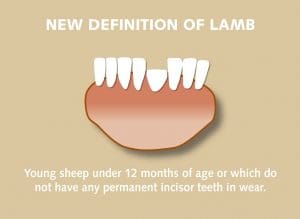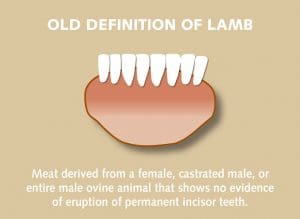
SPA president Allan Piggott.
SHEEP producers should not expect to have their lambs assessed under the newly endorsed lamb dentition definition until next year.
Sheep Producers Australia yesterday announced it had endorsed a change in Australia’s definition of lamb to be the same as the criteria accepted in New Zealand.
The new definition, as outlined in the New Zealand Lamb and Mutton Carcass Classification, will be ‘young sheep under 12 months of age or which do not have any permanent incisor teeth in wear’.
Under the previous classification, as soon as a lamb lost a baby tooth and a permanent tooth started coming through, it was considered hogget or mutton.
SPA president Allan Piggott said implementation of the new lamb definition would not happen “overnight” and producers should not expect to have their lambs assessed under the new definition in the next few weeks.
“Our advice at the moment is that this will probably take about 12 months; so we would be hopeful to have everything in place for the spring of 2019.
“That is our plan at this stage.”
The SPA’s decision has been acknowledged though not backed by NSW Farmers, which wants a focus on enhancing lamb product integrity through a quality-based grading system.

 The Australian Meat Industry Council has welcomed SPA’s policy position on a lamb definition change as having potential to bring significant benefits to sheep producers, processors and customers.
The Australian Meat Industry Council has welcomed SPA’s policy position on a lamb definition change as having potential to bring significant benefits to sheep producers, processors and customers.
Mr Piggott said there had been a good response from processors and “a number” were in favour of the definition change.
The SPA leader said an eating quality-based grading system for lamb had always been the aim of the body and sheep producers generally.
“We are very keen to produce the right product to keep consumers and we need good feedback to do that.”
Mr Abbott said dentition will become less important as the industry accessed technology to measure lamb eating quality.
He said consumers would also not see any change in their lamb products as a result of the definition change.
NSW Farmers wants focus on lamb grading system
NSW Farmers’ Sheepmeat Committee chair, Ian Cargill, said the association had not backed a lamb definition change, but noted that this is a national decision made after consultation with producers, processors, and state farming organisations.
“We recognise the decision that SPA has made and are keen to work with industry to ensure we get the implementation of the new definition right.
“NSW Farmers will work closely with Sheep Producers to ensure all the potential ramifications from the change are well-understood and appropriately managed through the implementation process.”
Mr Cargill said NSW Farmers is strongly supportive of industry investing in a cuts-based value system for lamb, including a sheep meat eating quality grading system that is underpinned by Meat Standards Australia.
“We know that definitions based on age and dentition are crude indicators of quality.
“The development of a cuts system based on eating quality will ensure we leverage the full value from the whole animal and meet consumer expectations,” he said.
He said the development of an eating quality system will deliver far greater returns to sheep producers than the current lamb definition change.
“Sheep producers in New South Wales produce a premium product and moving to a cuts-based eating quality system will ensure that their product’s value is more accurately recognised.”
AMIC welcomes lamb definition announcement
Australian Meat Industry Council chief executive officer Patrick Hutchinson said Australian lamb production, from farm to processor to retailer, has evolved significantly in the past 20 to 30 years, with significant advances in general husbandry, breeding, nutrition, animal welfare, processing techniques, ageing of product and refrigeration technology.
“This has allowed the Australian red meat industry to produce higher quality lamb more consistently across seasons and from year to year.
“Despite this, the definition used to describe “what a lamb is” has not changed since at least the mid-1900s, resulting in high-quality sheep meat being forced to be “down-graded” from lamb to hogget or mutton,” he said.
“This can result in a significant drop in the willingness of the consumer to purchase – despite no discernible difference in quality or taste – which flows back to lower returns for the processor, and a lower price offered to the farmer.
“AMIC looks forward to working with SPA on the implementation process of the proposed change to the lamb definition, and to bringing the benefits of this change to lamb producers, processors and consumers.”

I purchased loin lamb chops from a Lowlaws PC store in Canada and was so upset to find that my purchase of lamb was from halal treatment. My family finds it revolting and disgusted that the poor young lambs have to slowly bleed to death, cruel and unnecessary. Over here we are trying to outlaw this unnecessary treatment of animals. When I stayed in Australia, which I loved, I was so disappointed that I could not find lamb on menus in restaurants unless it was cooked in a manner whereby the taste of lamb was lost. The first meat I purchased when arriving home was lamb, we all enjoyed the meal. Please find another way of killing the lambs humanely as possible.
At last, a decision based on research and facts. To the people drawing up the regulation changes and to those who will vote them into law — the producers and processors are in favour of this change, make haste, no delays. Why can’t we aim for July 2018? If there is a will, there is a way.
…….about time……..50 years late….